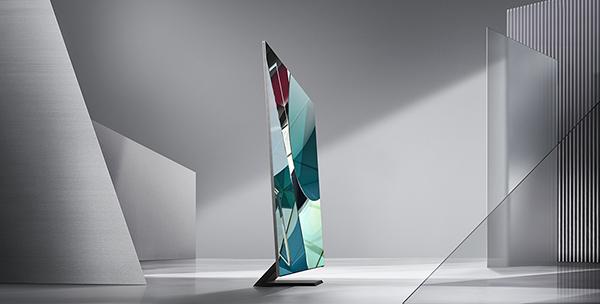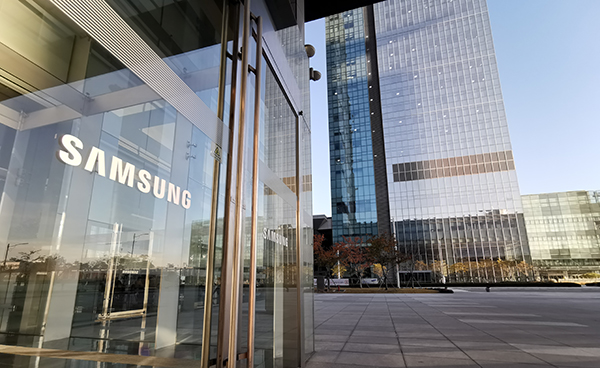Samsung's 2020 TV range to showcase neural network deep learning, infinity screens and innovative audio

To get a closer look, HCC travelled to Samsung’s Digital City in Suwon, 30 kilometres south of Seoul in South Korea. It's a sprawling technology complex comprising 128 buildings, with multiple R&D centres, shopping malls and even a basketball court or ten. Here we enjoyed an early hands-on with the QLED screens unveiled at CES yesterday.
Quick takeaway: AI upscaling is getting smarter and 8K TVs are becoming correspondingly cheaper. That’s a win win.
The brand’s 2020 8K range begins with the new ‘affordable’ Q800TS series, from 55in upwards, and peaks with the top-of-the-line Q950TS. The latter is astonishingly thin for a big TV with full array backlight, at just 14.9mm, and appears to be all panel. It’s only under closer inspection that its multi-driver speaker array becomes visible, revealed by perforations around the cabinet edge. Samsung's One Connect Box is retained on the Q950TS (and the brand's top-flight 4K offering), but doesn't feature elsewhere in 2020. It seems consumers just weren’t prepared to pay a premium for an external function junction.
Cosmetics, long a strong point for the brand, have been given high priority on the Q950TS. A new Infinity design, which sees the bezel reduced to just 2mm, minimises the black border to better showcase ultra-sharp 8K imagery. Samsung has also souped-up its AI upscaling, with the adoption of neural network deep learning, which – when used in association with machine learning – does a remarkably convincing job (based on my early demos) aggrandizing HD and 4K content. Enhanced texture creation, noise reduction, edge restoration and detail restoration all add depth and believability.
Deep learning aims to solve problems simply too complicated for machine learning. So how big a leap in PQ does it offer? 'Machine learning can distinguish between a man and a cat. Deep learning can tell you the breed of the cat,' we’re helpfully told.
With this level of image manipulation, perhaps native 8K content isn’t that important after all. Yet while it remains elusive, at least when it comes to movies and TV programming, it’s slowly becoming a reality, with gaming identified as an early opportunity. The incoming Xbox Series X console has the graphical chops to deliver 4320p imagery (although frame rates are yet to be revealed), and the PlayStation 5 is certain to follow suit. Codec advancements also promise more independent 8K content, via YouTube and Vimeo.

One thing you almost certainly won’t see on Samsung’s 2020 QLEDs is multi-HDR support. While I was visiting, there was zero indication that the brand was planning to add Dolby Vision support to its screens. It is, however, making changes to active tone mapping, which is applied to both HDR10 and HDR10+ on a frame- by-frame basis. Using an algorithm said to employ the same processing methodology as that used in an HDR10+ mastering suite, the results, it intimates, are just as good.
Samsung QLED screens have traditionally pushed the envelope when it comes to HDR peak brightness, and there’s even more to come. Its engineers have managed to improve HDR peak brightness on full array backlit models upwards of 20 per cent, thanks to judicious power management. Think of it as backlight power steering.
By controlling the current to the full array clusters, and applying whizz-bang signal processing, Samsung's 2020 sets can deliver seemingly brighter highlights and better colour saturation than ever before.
Enthusiasts may wonder just how faithful this extra pop is to the creative intent, and that’s impossible to tell, but such speculation is largely irrelevant. This is TV as beauty contest – and the results certainly look gorgeous.
There are also significant upgrades to audio. That Q950TS offers a 4.2.2 speaker configuration, with discrete drivers placed top, bottom and on the sides, allied to object tracking to handle soundstage steering. And the set comes with integrated sound calibration, using the microphone built in to the remote control.
Rather ingeniously, these models can be partnered with a 2020 Samsung soundbar, for what is called Symphony Sound. Rather than simply delegate audio duties to an attached soundbar using HDMI ARC, the two products work together, the high speakers in the TV partnering with the soundbar to deliver an immersive Dolby Atmos listening experience from both 'bar and screen. Demos of this co-op approach impressed with an expansive wall of sound. It makes you wonder why no one has thought to do it before.
Samsung’s 2020 best seller could well turn out to be the Q60T, a mass-market 4K model with big kerb appeal. Sibling models include the Q70T, Q80T and Q90T, which offer incremental benefits, including 4K Quantum upscaling.
Interestingly, Samsung has adopted a new Dual LED backlighting technique for its incoming Q60T and Q70T edge-lit QLEDs. By utilizing two different LED colour temperatures (5,000K and 2,000K), the company says it's been able to significantly boost contrast to offer better black level performance and improve viewing angles.
As an aside from all the performance frippery, Samsung has also worked up some fancy new ambient modes, including a rather cool music visualizer. Its Bixby smart platform will also start to preempt your picture mode choice, on the Q90T and above, based on viewing habits.
 |
Home Cinema Choice #351 is on sale now, featuring: Samsung S95D flagship OLED TV; Ascendo loudspeakers; Pioneer VSA-LX805 AV receiver; UST projector roundup; 2024’s summer movies; Conan 4K; and more
|







































